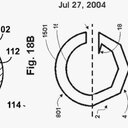β-Cyclodextrin-modified three-dimensional graphene oxide-wrapped melamine foam for the solid-phase extraction of flavonoids.
Açar sözlər
Mücərrəd
A new three-dimensional graphene oxide-wrapped melamine foam was prepared and used as a solid-phase extraction substrate. β-Cyclodextrin was fabricated onto the surface of three-dimensional graphene oxide-wrapped melamine foam by a chemical covalent interaction. In view of a specific surface area and a large delocalized π electron system of graphene oxide, in combination with a hydrophobic interior cavity and a hydrophilic peripheral face of β-cyclodextrin, the prepared extraction material was proposed for the determination of flavonoids. In order to demonstrate the extraction properties of the as-prepared material, the adsorption energies were theoretically calculated based on periodic density functional theory. Static-state and dynamic-state binding experiments were also investigated, which revealed the monolayer coverage of flavonoids onto the β-cyclodextrin/graphene oxide-wrapped melamine foams through the chemical adsorption. 1 H NMR spectroscopy indicated the formation of flavonoids-β-cyclodextrin inclusion complexes. Under the optimum conditions, the proposed method exhibited acceptable linear ranges (2-200 μg/L for rutin and quercetin-3-O-rhamnoside; 5-200 μg/L for quercetin) with correlation coefficients ranging from 0.9979 to 0.9994. The batch-to-batch reproducibility (n = 5) was 3.5-6.8%. Finally, the as-established method was satisfactorily applied for the determination of flavonoids in Lycium barbarum (Goji) samples with relative recoveries in the range of 77.9-102.6%.


